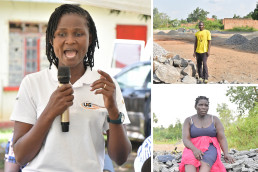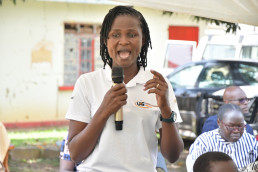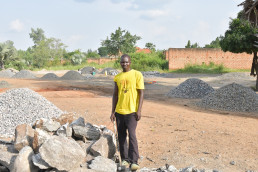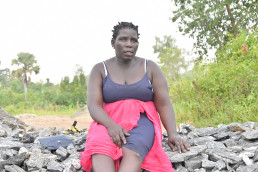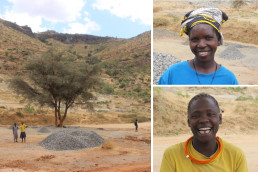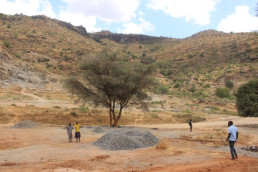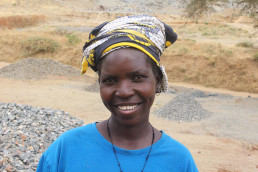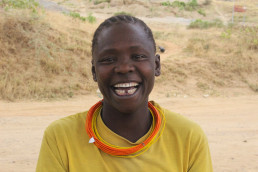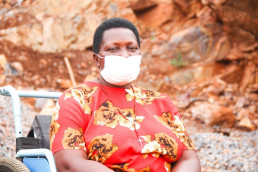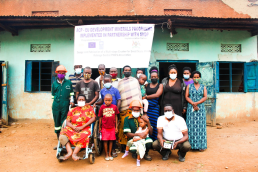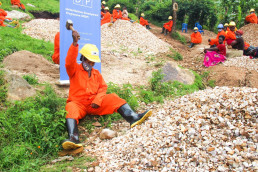Dialogue on De-risking Financing for ASMEs in Development Minerals
Kampala, Uganda25 October 2024
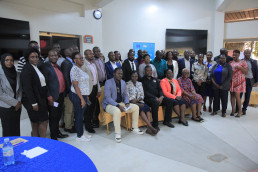
Artisanal miners encounter challenges in securing funding: as they operate informally and are involved in a sector often perceived as high-risk. However, access to finance is crucial for artisanal miners to transition from subsistence-level operations to more responsible and productive mining practices and engage in value-adding activities. In October 2024, the ACP-EU Development Minerals Programme hosted a dialogue on de-risking financing for Development Minerals value chains in Uganda. With over 40 participants from the public and private sectors, the event secured government commitments to create financial products suitable for artisanal miners and support cooperative registration to enhance access to finance, and guidance from banks for ASMEs to adopt ESG (Environmental, Social and Governance Standards) compliance for funding eligibility. Key stakeholders included UNDP, the Ministry of Energy and Mineral Development, and the Uganda Chamber of Mines and Petroleum.
Innovation and Enterprise Empowering Women Artisanal Miners of Uganda
Uganda is geologically endowed with a rich variety of valuable minerals present in commercially viable quantities. These include high-value minerals such as gold, uranium, iron ore, wolfram, nickel, copper, cobalt, tin, and rare earth elements, as well as development minerals like industrial minerals, construction materials, dimension stones, and semi-precious stones. The mining sector in Uganda encompasses both large-scale mining operations and artisanal and small-scale mining (ASM) activities. Despite having large underexploited mineral deposits, Uganda’s mining potential remains significantly untapped.
The Role of Mining in Uganda’s Socioeconomic Transformation
The mining sector holds immense potential to drive Uganda’s socioeconomic transformation and accelerate progress toward achieving the Sustainable Development Goals (SDGs). The mining sector plays a pivotal role in poverty reduction, employment generation, sustenance of livelihoods, and wealth creation. In the fiscal year 2022/23, mining contributed 1.9% to Uganda’s Gross Domestic Product (GDP), up from 1.4% the previous year. According to the Uganda Bureau of Statistics (UBOS), the mining and quarrying industry directly employs close to 600,000 people.
Artisanal and Small-Scale Mining (ASM): An Important Sector for Uganda
Artisanal and Small-Scale Mining (ASM) is prevalent in Uganda and is one of the most important rural non-farm economic activities. ASM contributes over 90% of Uganda’s mining production and employs more than 60% of the mining workforce. According to a baseline assessment and value chain analysis of the development minerals sector in Uganda, ASM contributes at least $850 million USD in production value to Uganda’s economy. If integrated into the national economic statistics, Uganda’s GDP would grow by an additional 1.3%.
Women constitute a significant portion of the ASM workforce, engaging in roles from panning and processing to trading goods and services. Despite the high value of ASM production, the majority of the workforce earns minimal income. ASM, largely an informal poverty-driven activity, often results in environmental damage and poses serious health and safety risks for workers and surrounding communities, with limited economic benefits. However, if properly harnessed, ASM has the potential to drive the growth of decent work for millions, foster micro and small enterprise (MSE) growth, increase household incomes, boost government revenues, and accelerate progress towards several SDGs.
Challenges Facing ASM in Uganda
Numerous factors have impeded the potential of ASM operations to accelerate Uganda’s economic prosperity and sustainable development. Key constraints include:
- Limited Access to Finance: The informal nature of ASM and lack of collateral limit capacity to invest in equipment, technology, and safety measures.
- Inadequate Entrepreneurial Skills and Competences: Many ASM operators lack the necessary business acumen to manage their operations efficiently.
- Limited Access to Markets and Value Chains: Artisanal miners often struggle to connect with broader markets, reducing their income potential.
- Lack of Technical Knowledge and Skills: ASM operators often lack the technical expertise required to adopt safer and more efficient mining practices.
- Absence of Geological Data: Limited access to geological data hinders effective mining operations.
- Complex Regulations: Inconsistent regulations create barriers to entry and compliance burdens for artisanal and small-scale miners.
The sector also faces sustainability challenges due to the methods used in extraction, processing, and utilization of development minerals. Recognizing these challenges, the United Nations Development Programme (UNDP) has included support for ASM operations in its Uganda Country Programme 2021-2025, aiming to promote economic prosperity, job creation, and sustainable development.
UNDP’s Efforts to Support ASM
In partnership with the Organization of African, Caribbean and Pacific Group of States (OACPS) and the European Union (EU), UNDP is addressing these challenges through various initiatives:
- Strengthening Regulatory Frameworks: Ensuring issues pertaining to ASM enterprises (ASMEs) are mainstreamed into mining and mineral laws and policies.
- Environmental and Social Safeguards: Providing onsite training in sustainable mining practices, developing handbooks on conflict management, safety, health, and environmental restoration.
- Technological Innovation: Creating digital platforms to improve market access, providing grants for formalization, value addition, and job creation for youth, and supporting technological development in the mining sector.
Atim Ki Kuma Quarry Mine
Atim Ki Kuma Quarry Mine, founded by Ms. Comfort Okello in Gulu, Northern Uganda, is a success story of the UNDP-implemented ACP-EU Development Minerals Programme. The quarry received a grant of 18 million UGX ($4,800 USD), which was used to establish a Village Savings and Loans Association (revolving fund) and purchase essential equipment such as motorized water pumps, sledgehammers, helmets, gloves, and masks. Additionally, the grant funded capacity-building training in first aid response to manage onsite accidents.
The revolving fund and business growth at the quarry have significantly improved the capital base and living standards for the women involved. Ms. Okello mentions that borrowing from the fund has enabled her to open a hardware shop in a nearby trading center, providing essential items for the quarry site. The grant and equipment have increased productivity, reduced production costs, and boosted profits.
Networking and Capacity Building
Beyond financial support, the ACP-EU Development Minerals Programme has provided the group with networking opportunities and strategic partnerships. Ms. Okello participated in a forum on sustainable mineral value chains in Zambia, where she shared experiences and adopted climate-smart mining practices. Her association now runs a campaign to restore the environment by planting trees along swamps and streams.
Through UNDP’s support, the group was also connected to the African Centre for Energy and Mineral Policy, which built a drainable pit latrine with a 45-year lifespan and drilled a clean borehole with a solar pump for improved site safety.
Future Needs and Expansion
The group’s biggest need for expansion and growth is acquiring a machine to grade, extract, crush, and sort stones, sieve stone dust, cut stones, and design them for productive use. This machinery would significantly boost productivity and profitability.
Empowering ASM for Sustainable Development
The success story of Atim Ki Kuma Quarry Mine highlights the transformative power of well-supported artisanal mining. With the right tools, training, and financial backing, artisanal miners can drive substantial economic growth, benefiting their communities and the entire country. Empowering ASM groups with an enabling environment for production and growth serves both the macro economy and micro-level communities engaging in such activities.
The ACP-EU Development Minerals Programme and UNDP’s efforts have laid a strong foundation for the continued success and growth of ASM operations. The lessons learned and progress made at Atim Ki Kuma Quarry Mine offer a blueprint for similar initiatives across Uganda and beyond.
The future of Uganda’s mining sector is bright, with the promise of increased economic empowerment and sustainable development for communities engaged in artisanal mining.
This story was originally published by UNDP Uganda on June 24, 2024
13th Annual Mineral Wealth Conference
Kampala, Uganda1 - 2 October 2024
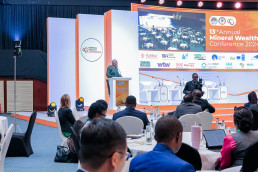
The ACP-EU Development Minerals Programme supported the 13th Annual Mineral Wealth Conference (1-2 October 2024, Kampala), themed “Leveraging Critical Minerals for Sustainable Development and Economic Transformation.” Organized by the Uganda Chamber of Mines and Petroleum and the Ministry of Energy and Mineral Development, the event drew over 700 delegates.
The Programme supported visibility of artisanal and small-scale miners as valuable actors in the mining sector. It showcased initiatives empowering women in mining, promoting inclusion of marginalized groups, more sustainable practices minimizing the environmental impact, and value addition to Development Minerals. The Programme supported the launch of the Junior Chamber of Mines to foster youth innovation in mining.
Exhibitions supported by the Programme highlighted advancements in value addition, digitization, and research, demonstrating its extensive support for Uganda’s Development Minerals sector.
Transforming Lives of Karamoja Women Miners
Uganda is undergoing a construction boom driven by infrastructural and other industrialization developments that have spurred new and increased demand for development minerals that are mined, processed, manufactured and applied domestically in sectors including manufacturing, building, construction and industry. These include sand, clay, limestone, gypsum, salt, stone aggregate, kaolin and gravel, dimension stones like marble and granite, and semi-precious stones like garnet and tourmaline that have a high level of economic linkage and utilization close to the location where the commodity is mined. The prevalence of development minerals in Uganda is high, and the industry generates an estimated US$350 million annually, directly supporting 390,000 Ugandans, 44 percent of whom are women.
This attests to the potential of the development minerals’ sector to create jobs, spur innovation, and stimulate investment and infrastructure development. Yet if not properly managed, the sector activities such as mining can also lead to environmental degradation, displaced populations, inequality and increased conflict.
The Government of Uganda has put in place policy and legal provisions, and a strategy targeting the artisanal and small-scale mining (ASM) sector, to harness the opportunities that the sector presents.
To maximize the socioeconomic development of Uganda’s mining industry, the United Nations Development Programme (UNDP) has worked with the Ministry of Energy and Mineral Development, the Ministry of Trade, Industry and Cooperatives, and others to support the training of various artisanal small-scale mining enterprises (ASMEs) in 25 districts in various facets of business management and financial literacy.
In Karamoja sub-region alone, UNDP has implemented the ACP-EU Development Minerals Programme and trained over 30 Karamoja women miners on how to operate their businesses. An initiative of the African, Caribbean and Pacific (ACP) Group of States, this programme is a collaboration of the European Union and UNDP and seeks to profile and improve the management of development minerals.
Voices of beneficiaries
Since its inception in 2018, the programme has supported ASMEs to enhance productivity, create jobs, increase income, and put in place environmental and social safeguards in and around mining areas.
Two women miners, Miriam Aisu and Lucy Nakiru, have received training and support from the programme for improved skills and income from mining of development minerals. They are both from Loptuk sub-county in Moroto district and speak fondly of how much the programme has transformed their lives.
“I am the Treasurer of the Mount Moroto Women Development Mineral Association,” Miriam Aisu said. “I am delighted to report that this initiative gave me the skills and confidence to negotiate with customers. As a result, I now run a pastry shop across the street. While working at the mine, I also learned how to be healthier and safer,” she added.
Similarly, a beaming Lucy Nakiru said, “I made the decision to start a mining operation since it was straightforward for me to get started and because I observed that many wealthy inhabitants of our area were seeking hardcore and aggregate stones to construct their houses.” She added, “As a woman, I now at least have some money to spend on food, educational expenses and medical expenses for my four children. I am grateful to UNDP for their assistance which has given me the confidence to launch future businesses, utilizing this one as a launchpad.”
Building forward better from COVID-19
ASMEs in the development minerals industry have increased recovery efforts after experiencing financial strain because of decreased output and other operational disruptions throughout the course of the COVID-19 pandemic. All parties involved are still making concerted efforts to support this economic recovery, by enhancing the livelihood security, resilience, and sustainability of mining operations.
The 2030 Agenda for sustainable development and the Sustainable Development Goals (SDGs) represent the United Nations’ plan of action for social inclusion, environmental sustainability, and economic development. Under this lens, Uganda’s mining industry has an unprecedented opportunity to mobilize human, physical, technological and financial resources to advance the SDGs and to achieve Uganda’s development aspirations.
To deliver on the sustainable development goals and 2030 agenda, UNDP will continue to ensure an inclusive mining sector which benefits Uganda’s economic, social and environmental component of sustainable development, and one that encourages economic expansion, raises tax revenue, creates jobs and aids in the improvement of infrastructure.
This story was originally published by UNDP Uganda on December 22, 2022
Creating Livelihood Opportunities in Uganda
Development minerals are widespread in Uganda, and the sector contributes approximately 350 million USD in production value annually while directly employing 390,000 Ugandans (44% of those being women). The COVID-19 pandemic put a strain on market and production in the development minerals sector which has led to livelihood loss, increased health risks during mining, as well as exclusion of socially vulnerable groups such as women and youth.
Kirabo Mackline Nalongo is a woman leader and secretary of Kabingo Central People with Disabilities Association in Kabingo subcounty, Isingiro District, Western Uganda. She works together with a team of 20 members stone quarrying in the rocky hilly areas of Kabingo subcounty.
To address constraints faced by small and medium enterprises (SMEs), the ACP-EU Development Minerals Programme an initiative of the African, Caribbean and Pacific (ACP) Group of States, financed by the European Union and the United Nations Development Programme (UNDP), and implemented by UNDP provides small grants to support associations, civil society organisations, and other stakeholders in the development minerals sector. 12 grantees in Uganda were selected for award of small grants and before commencing implementation, the 12 grantees were oriented on principles of UNDP project management and communication guidelines.
We spoke to Kirabo to learn about how the small grants programme has helped her association and its members improve their income, production, health, and safety.
“Previously our income was very low and all the money we got was spent on daily feeding of our families,” said Kirabo. But thanks to UNDP and other partners for this small grant, now we earn some extra money which has enabled us to save and venture into other projects like piggery and tailoring. We were also given face masks and have a washing area to guard against COVID-19. Similarly, we were also supplied with protective gear to provide safety against injuries at work.”
Growing up, Kirabo recalls how people with disability had always been ignored in her society. She explains that most of the time she was considered useless and a burden to society. Being the most visible and easiest option to pursue, she opted to start a stone quarrying business with the intention of proving doubters wrong that disability does not have to mean inability.
“The people with disability have previously been ignored,” she said. “But now they are well known, and people are appreciating their services.”
Development minerals are widespread in Uganda, and the sector contributes approximately 350 million USD in production value annually while directly employing 390,000 Ugandans (44% of those being women). The COVID-19 pandemic put a strain on market and production in the development minerals sector which has led to livelihood loss, increased health risks during mining, as well as exclusion of socially vulnerable groups such as women and youth.
Kirabo Mackline Nalongo is a woman leader and secretary of Kabingo Central People with Disabilities Association in Kabingo subcounty, Isingiro District, Western Uganda. She works together with a team of 20 members stone quarrying in the rocky hilly areas of Kabingo subcounty.
To address constraints faced by small and medium enterprises (SMEs), the ACP-EU Development Minerals Programme an initiative of the African, Caribbean and Pacific (ACP) Group of States, financed by the European Union and the United Nations Development Programme (UNDP), and implemented by UNDP provides small grants to support associations, civil society organisations, and other stakeholders in the development minerals sector. 12 grantees in Uganda were selected for award of small grants and before commencing implementation, the 12 grantees were oriented on principles of UNDP project management and communication guidelines.
We spoke to Kirabo to learn about how the small grants programme has helped her association and its members improve their income, production, health, and safety.
“Previously our income was very low and all the money we got was spent on daily feeding of our families,” said Kirabo. But thanks to UNDP and other partners for this small grant, now we earn some extra money which has enabled us to save and venture into other projects like piggery and tailoring. We were also given face masks and have a washing area to guard against COVID-19. Similarly, we were also supplied with protective gear to provide safety against injuries at work.”
Growing up, Kirabo recalls how people with disability had always been ignored in her society. She explains that most of the time she was considered useless and a burden to society. Being the most visible and easiest option to pursue, she opted to start a stone quarrying business with the intention of proving doubters wrong that disability does not have to mean inability.
“The people with disability have previously been ignored,” she said. “But now they are well known, and people are appreciating their services.”
The Association was established in 2018 and was officially registered in May 2021, made up of 20 persons with disability out of which 15 are women, the objective of the association is to achieve financial sustainability. In furtherance of this objective, the association started a stone quarry, piggery and later tailoring business with all profits re-invested.
UNDP held a meeting with group members who appreciated the support given, noting that the community has benefited through job creation in the mining sites of Kabingo county.
The Chairman of the association disclosed that when one member lost an eye at the quarry from a flying stone, the association sought to mechanize its operations to prevent further injuries on site. They therefore started using a stone crusher machine. While at first this proposition seemed expensive and daunting, UNDP support has made this dream become a reality. They have designed a protype stone crusher machine which they intend to fabricate. Meanwhile, there has been progress on the implementation of the grant activities in respect of research and design for the prototype, as well as procurement of necessary materials.
The first phase of this initiative has covered three northern region grantees based in the districts of Nebbi, Lira and Gulu, while the second phase covers five grantees based in the Western and Central regions which are in the districts of Isingiro, Ibanda, Hoima, Bushenyi and Wakiso.
The 2030 Agenda for sustainable development and the Sustainable Development Goals (SDGs) represent the United Nations’ plan of action for social inclusion, environmental sustainability, and economic development. It is our shared belief that the mining industry has an unprecedented opportunity to mobilize human, physical, technological, and financial resources to advance the SDGs and to achieve Uganda’s development aspirations.
Mining is a global industry and is often located in remote ecologically sensitive and less developed areas that include many indigenous lands and territories. When managed appropriately it can create jobs, spur innovation, and bring investment and infrastructure at a game-changing scale. Yet if managed poorly, mining can also lead to environmental degradation, displaced populations, inequality and increased conflict, among other challenges.
The Development Minerals sector is dominated by socio-economically disadvantaged artisanal miners of small and medium business actors who experienced unprecedented business disruptions and shocks because of the COVID 19 Pandemic. The stringent lockdown measures by Government of Uganda to stem the transmission of the virus inevitably resulted into abandonment of the quarrying sites, loss of jobs and business opportunities. COVID19 put a strain on Market and production in the Quarrying activities thus leading to livelihood loss, increased health risks during mining as well as exclusion of socially vulnerable groups such as women and youth from related supply and value chains in the sector.
UNDP selected Twelve (12) grantees for the award of small grants, and all had received funds by end of September 2021. The grantees were grouped into associations namely, Environmental Women in Action for Development (EWAD), Mid-Western Region Anti-Corruption Coalition (MIRAC), Ibanda Community Based Artisanal Miners (ICBAM), Kabingo Central PWDs Association, and Buhimba Quarry Association. Before commencing implementation, the 12 grantees were oriented about UNDP project management and communication guidelines. Through UNDP’s ACP-EU Development Minerals Programme, small and medium enterprises (SMEs) will continue to be supported to thrive in this sector and improve the livelihoods of those who are most vulnerable.
This story was originally published by UNDP Uganda on February 11, 2022
https://www.undp.org/uganda/blog/development-minerals-creating-livelihood-opportunities-uganda

